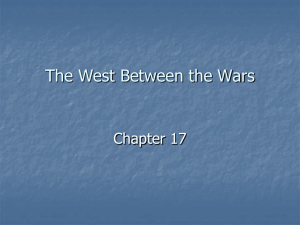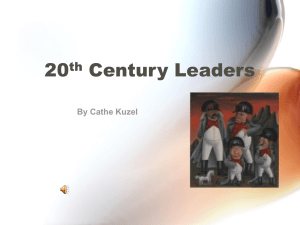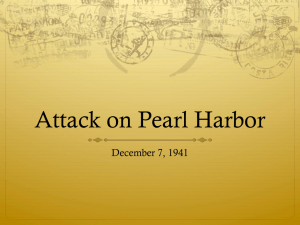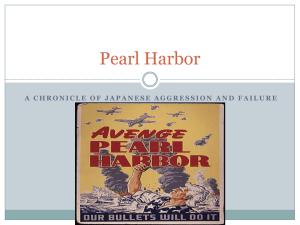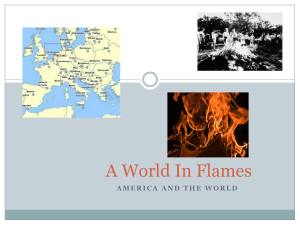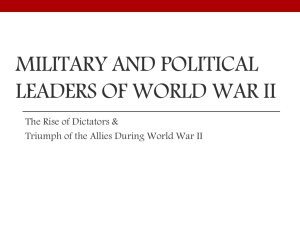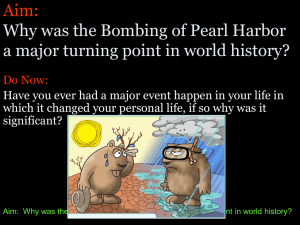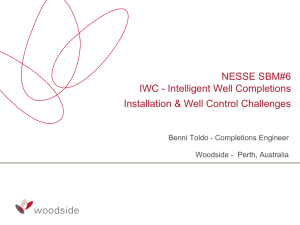Chapter 10 Notes (blank)
advertisement
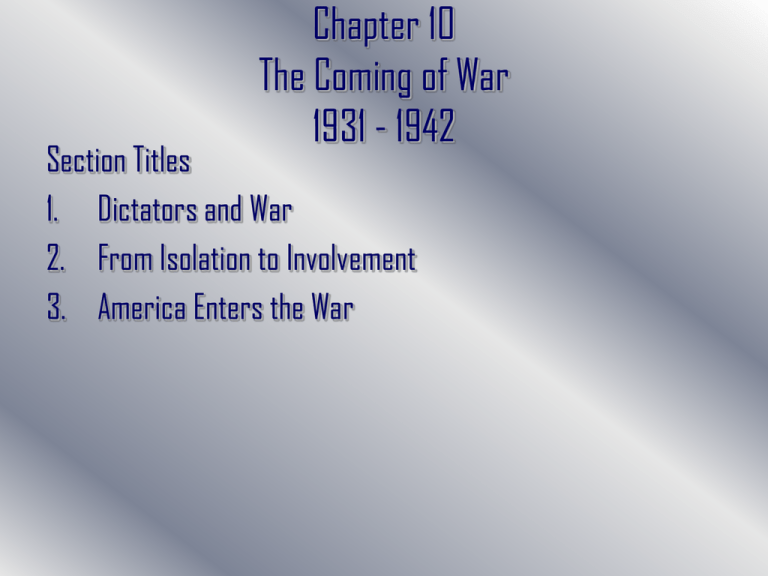
Chapter 10 The Coming of War 1931 - 1942 Section Titles 1. Dictators and War 2. From Isolation to Involvement 3. America Enters the War Chapter 10 Section 1 Dictators and War NEW TERMS: TOTALITARIANISM JOSEPH STALIN BENITO MUSSOLINI ADOLF HITLER ANTI-SEMITIC SPANISH CIVIL WAR APPEASEMENT ANSCHLUSS MUNICH PACT Chapter 10 The Coming of War BELLRINGER WHAT DO YOU REMEMBER ABOUT THE END OF WWI, THE TREATY OF VERSAILLES AND THE GREAT DEPRESSION? (Work with your partner to come up with a list) Chapter 10 Section 1 Dictators and War Lesson Essential Question Why did totalitarian states rise after World War I, what did they do and what was the world response? Chapter 10 Section 1 Dictators and War CHECKPOINT QUESTIONS 1. How were dictators and militaristic regimes able to rise in the 1930’s? 2. What were the actions taken by aggressive regimes in Europe and Asia? 3. What were the responses of Britain, France and the US to the aggressive regimes? Chapter 10 Section 1 Dictators and War I. A Bitter Peace Unravels A. Treaty of ______________ – ended WWI 1. 2. 3. 4. 5. _______________ and Russia had no say in treaty Britain, US and France had most say Italy and Japan upset about treaty too Caused resentment in many ways (revenge) _____________________________ (14 points) Chapter 10 Section 1 Dictators and War II. Totalitarianism (chart page 325) A. Repression in the Soviet Union 1. _________________ a. b. 2. _______________________ – means “man of steel” a. a. 1917 Bolshevik Rev. 1924 dies ruthless, cruel, suspicious and very intelligent Purges – killing of suspected traitors 1. 2. Great Terror – 1930’s purge of Communist Party (death or imprisonment of 1 million including army officers) Estimates are over _____ million a. Stayed in power with fear and propaganda Chapter 10 Section 1 Dictators and War II. Totalitarianism (continued) B. Repression in Italy 1. Causes a. Did not get land on Adriatic b. Economic depression c. Communist movement 2. _____________________ a. 1919 – founded ________________ Party b. Black Shirts – followers that fought socialists and communists c. Il Duce – 1922…complete control Chapter 10 Section 1 Dictators and War III. Aggressive leaders in Germany and Japan A. Germany - Rise of _________________ 1. Causes a. b. c. d. 2. Weimar Republic – post WWI democracy Severe depression Anger of treaty Great Depression worsens economy (1930’s) ________________________ a. b. c. d. Leader of Nazi party __________________– book outlining Ger. Problems (anti-communist and anti-Semitic) Seizing Power – he becomes chancellor in ’33 and pres in ’35 and consolidates power and controls completely Ends depression, but restricts freedoms and persecutes Chapter 10 Section 1 Dictators and War B. Japan – ______________________ (pp. 328) 1. 2. 3. Democratic change in the 20’s Depression brings back military leaders a. Not totalitarian, but constitutional monarchy is ruled by weak emperor b. Military makes most decisions Expansion to limit effect of Depression a. 1931 – ____________________ b. 1937 – the rest of China 1. “_________________________” – brutal seige of capital city Chapter 10 Section 1 Dictators and War CHECKPOINT QUESTION How were dictators and militaristic regimes able to rise in the 1930’s? Chapter 10 Section 1 Dictators and War IV. Dictators Turn to Aggression A. League of Nations – weak 1. no USA 2. only as strong as it’s members (Depression led to limited resolve) B. Hitler and other aggression 1. 2. Defiance of Versailles __________________________ – living space a. b. 3. Saar, troops in Rhineland, Italy invades Ethiopia No actions taken by League against Ger. or Italy ________________________________ 1. Francisco Franco (Fascists/nationalist leader) received aid from Ger and Italy…..most allies stayed out Chapter 10 Section 1 Dictators and War CHECKPOINT QUESTION 2. What were the actions taken by aggressive regimes in Europe and Asia? Graphic Organizer Chapter 10 Section 1 Dictators and War V. Appeasement A. Why? 1. 2. 3. B. WWI Ger. buffer between West and S. Union US and economic troubles “Peace in our Time” 1. 2. 3. ______________________ – Austria ________________________ – western Czechoslovakia ______________________ Conference - 1938 a. b. Hitler, Chamberlain and Daladier Munich Pact – Gr. Britain and Fr. Gave up Sudetenland for peace – only postponed war 11 months Chapter 10 Section 1 Dictators and War CHECKPOINT QUESTION 3. What were the responses of Britain, France and the US to the aggressive regimes? Graphic Organizer Section Quiz Chapter 10 Section 2 From Isolation to Involvement BELLRINGER How would you define the word isolation? Chapter 10 Section 2 From Isolation to Involvement NEW TERMS: Blitzkrieg Axis Powers Allies Winston Churchill Neutrality Act of 1939 Tripartite Pact Lend-Lease Act Atlantic Charter Chapter 10 Section 2 From Isolation to Involvement LESSON ESSENTIAL QUESTION How did Americans react to events in Europe and Asia in the early years of World War II? Chapter 10 Section 2 From Isolation to Involvement CHECKPOINT QUESTIONS 1. What was the course of WWII in the early years in Europe? 2. How would you describe FDR’s foreign policy in the mid-30’s and the great debate between interventionists and isolationists? 3. How did the US become more involved in the conflict? Chapter 10 Section 2 From Isolation to Involvement I. FDR Opposes Aggression A. _______________ attack on China 1. 2. II. Panay incident….. Call for isolation of Japan War erupts in Europe A. B. C. _________________ broken – Ger. Absorbs all of Czech. GB and Fr. Sign alliance with Poland --- Ger. Signs pact with __________ Sept. 1, 1939 – Ger. ________________ of Poland….17th USSR invades from east…..by the end of the month Poland falls and Fr. and GB are @ war Chapter 10 Section 2 From Isolation to Involvement II. War Erupts in Europe (continued) A. The sides! 1. 2. B. C. Axis Powers – ______________ __________________ ________________ Allies – Britain, France and later….USA, USSR and China “___________________” – 8 month quiet period 1940 – 1. 2. 3. April 9th – Ger armies attack Denmark and Norway May 10th – attack Netherlands, Belgium and Luxembourg French defenses – Maginot Line and Belgium border defenses 1. 2. 4. Ardennes – forested area that seemed attack proof…. ______________________________ -338,000 Fr and Brit. Troops escape to GB French Defeat (35 days) – and division of France (pp.333) 1. Occupied France and Vichy France Chapter 10 Section 2 From Isolation to Involvement II. War Erupts in Europe (continued) C. 1940 1. ______________________ – July (pp 335) a. Operation Sea Lion – Hitler’s plan to invade Britain depended on air superiority, but his Luftwaffe could not defeat the RAF even with the “blitz” of London…..eventually Hitler postpones invasion Chapter 10 Section 2 From Isolation to Involvement Checkpoint Question What was the course of WWII in the early years in Europe? Chapter 10 Section 2 From Isolation to Involvement III. American Debate Involvement (pp. 336, 337) A. American favors Isolation 1. 2. Great Depression WWI a. b. 3. _____________________________ (1935, 1936, 1937) a. b. c. B. Deadly, expensive and pointless Big business conspiracy (Nye Committee) Bannned sailing of ships of at war nations Banned loans to warring nations Banned the sale of arms or munitions (to either side in war) ________________________ favor aiding the Allies 1. 2. 3. Neutrality Act of 1939 – “___________________________” Committee to Defend American by Aiding the Allies The America First Committee – Charles Lindbergh – leading isolationist Chapter 10 Section 2 From Isolation to Involvement Checkpoint Question 2. How would you describe FDR’s foreign policy in the mid-30’s and the great debate between interventionists and isolationists? Chapter 10 Section 2 From Isolation to Involvement IV. America Takes Steps Toward War A. Sept. 1940 1. 2. 3. 4. B. _____________________ Pact – Germany, Italy and Japan become allies ________________________________________ – peacetime draft Destroyers to Britain for naval base Nov. 1940 – FDR defeats _____________________ for 3rd term as president More US aid 1. 2. 3. 4. 5. “________________” speech – speech, worship, from want and fear (pp 339) ________________________ – March 1941 “the great arsenal for democracy” _____________________– signed by FDR and Churchill about post-war world Undeclared war in the Atlantic – Ger u-boats vs. US ships June 1941 – Germany attacks _____________ Chapter 10 Section 2 From Isolation to Involvement Checkpoint Question 3. How did the US become more involved in the conflict? Graphic Organizer Section Quiz Chapter 10 Section 3 America Enters the War BELLRINGER IF IRAN DOESN’T FOLLOW UNITED STATES AND UNITED NATIONS REQUESTS TO STOP IT’S NUCLEAR PROGRAM, SHOULD THE US INTERVENE MILITARILY? Chapter 10 Section 3 America Enters the War NEW TERMS HIDEKI TOJO PEARL HARBOR WAC DOUGLAS MACARTHUR BATAAN DEATH MARCH BATTLE OF CORAL SEA Chapter 10 Section 3 America Enters the War BELLRINGER DO YOU THINK THE US WOULD HAVE ENTERED WWII IF JAPAN HAD NOT ATTACKED AT PEARL HARBOR? EXPLAIN YOUR ANSWER! Chapter 10 Section 3 America Enters the War Lesson Essential Question How did the United States react to the Japanese attack on Pearl Harbor? Chapter 10 Section 3 America Enters the War CHECKPOINT QUESTIONS 1. WHY DID JAPAN DECIDE TO ATTACK PEARL HARBOR? DESCRIBE IT. 2. HOW DID THE UNITED STATES MOBILIZE FOR WAR AFTER THE ATTACK ON PEARL HARBOR? 3. WHAT WAS THE COURSE OF THE WAR IN THE PACIFIC THROUGH THE SUMMER OF 1942? Chapter 10 Section 3 America Enters the War I. America Enters the War A. Japan Attacks the US 1. 2. 3. 4. Pacific rivalry – US in Guam, Phillippines… support of China US ____________________ on supplies – oil, iron ore, fuel, steel and rubber __________________ and negotiations – try to end dispute Nov. 1941 – _________________ (US sec. of state) rejects Japan’s latest demands…..Japan makes decision to attack!! Chapter 10 Section 3 America Enters the War I. America Enters the War A. Japan Attacks the US (cont.) 5. Pearl Harbor – ___________________________ a. b. c. d. e. f. Vice Admiral _______________________ 6 Aircraft Carriers, 360 planes, battleships and subs RESULTS – nearly _______ deaths, 8 battleships severely damaged, 3 destroyers unusable, 3 light cruisers damaged, over 160 aircraft destroyed and 128 more damaged – Arizona, Oklahoma and Utah irreparable damage ___________________________ out of commission for 6 months – but survives Nagumo too conservative – no 3rd wave, didn’t find carriers and went back towards Japan fearing counterstrike US declares war (House votes 388 – 1, Senate unanimous) Germany and Italy declare war on US Chapter 10 Section 3 America Enters the War 1. CHECKPOINT QUESTION WHY DID JAPAN DECIDE TO ATTACK PEARL HARBOR? DESCRIBE IT. Chapter 10 Section 3 America Enters the War II. Mobilizing for War A. Joining the military 1. All branches expanded from ’41 to ’42, a. b. 2. Mexican, Native, Africans and women joined the cause in large numbers WACS and Army Nurse Corps Mobilizing Industry a. b. c. d. 1942 – ____________________________________(WPB) – oversee conversion of industry __________________________________________ (OWM) – supervise allocation of scare materials, regulate the production of civilian goods, establish production contracts, negotiate with labor and control inflation. War spending ends depression By 1944, US production ______________ that of the Axis powers combined Chapter 10 Section 3 America Enters the War CHECKPOINT QUESTION 2. HOW DID THE UNITED STATES MOBILIZE FOR WAR AFTER THE ATTACK ON PEARL HARBOR? Chapter 10 Section 3 America Enters the War III. Fighting in the Pacific A. Philippines Fall – 1. 2. Japanese take Guam, Wake Island and Hong Kong Dec. 22, 1941 – Japanese attack of _________________________, a. b. c. 3. US forced to retreat to Bataan Peninsula and Corregidor Island MacArthur ordered to evacuate to Austrailia May 42, _________ Allied troops surrender – sick and injured forced on the ______________________________ (7,000 die) Japanese gains and US strikes– a. b. c. d. By summer of ’42 – Japanese ready to completely control from Indian Ocean Australia, New Zealand and the central Pacific _______________________ – attack of mainland Japan by 16 B-25 bombers ___________________-May 1942 – total air battle, draw but US stopped Japanese attack Doolittle Raid and Coral Sea – gave US confidence at the end of 1942 Writing Prompt How would you have reacted to Pearl Harbor? Chapter 10 Section 3 America Enters the War CHECKPOINT QUESTION 3. WHAT WAS THE COURSE OF THE WAR IN THE PACIFIC THROUGH THE SUMMER OF 1942? Graphic Organizer Graphic Organizer 2 Section Quiz
